Week 28: More Single Column Ties
The single column tie, the starting point of most ties. Many different knots can be used to create a cuff. Each will yield a tie with different characteristics. At first, it is wise to pick one and master it, and down the road, it becomes interesting to compare different methods. identify in which context a technique would be more adapted than another and build a system to decide which to use when.
The goal of this week is to try different single column ties, compare them and add our favourite to our toolbox.
Note – this page is a sample of the rope365 content. Subscribe to the mailing list to get notified when the full content gets published.
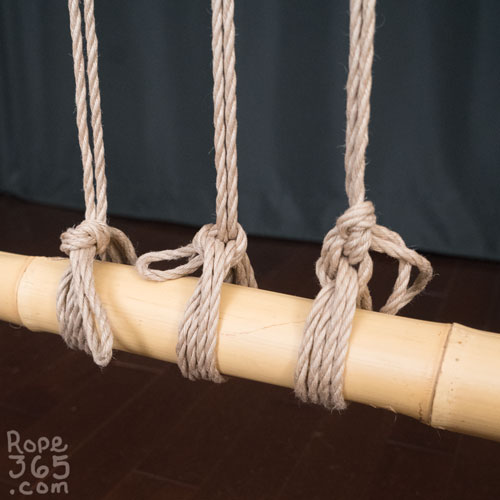 Day 190: Square and Granny – aka boola boola, yuki knot – This single column tie is probably the most classic because of its simplicity and speed but also comes with the limitations as it can collapse and turn into a slip knot. It consists of two half knots on top of each other and depending on the direction, will yield two different knots. The square knot (aka reef knot or honmusubi 本結び) always remains easy to untie but may have a tendency to collapse depending on the direction in tension. The granny knot (aka tatemusubi 縦結び) is slightly more secure but also more difficult to untie. You can add a twist or an additional half knot to make it more secure. Look at Day 18 for a refresher of the difference between the granny and the square knot. Day 190: Square and Granny – aka boola boola, yuki knot – This single column tie is probably the most classic because of its simplicity and speed but also comes with the limitations as it can collapse and turn into a slip knot. It consists of two half knots on top of each other and depending on the direction, will yield two different knots. The square knot (aka reef knot or honmusubi 本結び) always remains easy to untie but may have a tendency to collapse depending on the direction in tension. The granny knot (aka tatemusubi 縦結び) is slightly more secure but also more difficult to untie. You can add a twist or an additional half knot to make it more secure. Look at Day 18 for a refresher of the difference between the granny and the square knot.
Inspirations and Resources
|
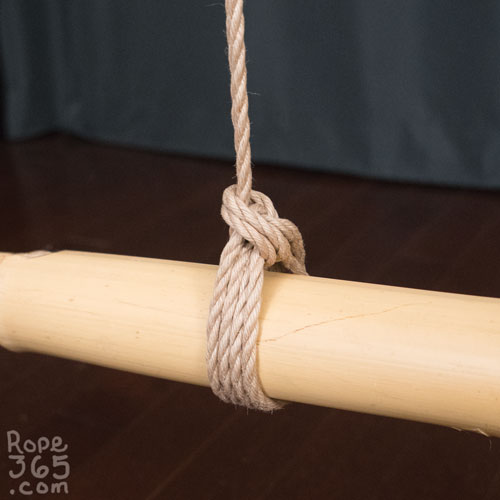 Day 191: Lark’s Head – This single column tie is created from lark’s head followed by a reversed tension and a half hitch. It is very solid and will not collapse. Unlike most single column ties, it doesn’t have a bight, which is a good thing if we don’t want to have a piece of rope dangling for a cleaner look. This is also a trade, without the bight, we can’t untie from the bight or use it later on as an attachment point. This tie requires more time to tie as it requires two full pull-throughs of the rope. Day 191: Lark’s Head – This single column tie is created from lark’s head followed by a reversed tension and a half hitch. It is very solid and will not collapse. Unlike most single column ties, it doesn’t have a bight, which is a good thing if we don’t want to have a piece of rope dangling for a cleaner look. This is also a trade, without the bight, we can’t untie from the bight or use it later on as an attachment point. This tie requires more time to tie as it requires two full pull-throughs of the rope.
|
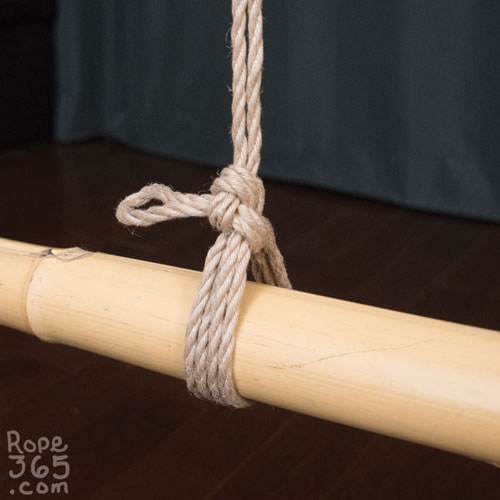 Day 192: Reversed French Bowline – aka Wykd fast bowline – This single column tie is based on a bowline technique and yields a very fast single column tie that is more solid than the square or granny knot though a bit more tricky to tie. It remains easy to untie under tension, which makes it a popular alternative for box tie starting point. It can still capsize under heavy loads or when using slippery rope. Day 192: Reversed French Bowline – aka Wykd fast bowline – This single column tie is based on a bowline technique and yields a very fast single column tie that is more solid than the square or granny knot though a bit more tricky to tie. It remains easy to untie under tension, which makes it a popular alternative for box tie starting point. It can still capsize under heavy loads or when using slippery rope.
|
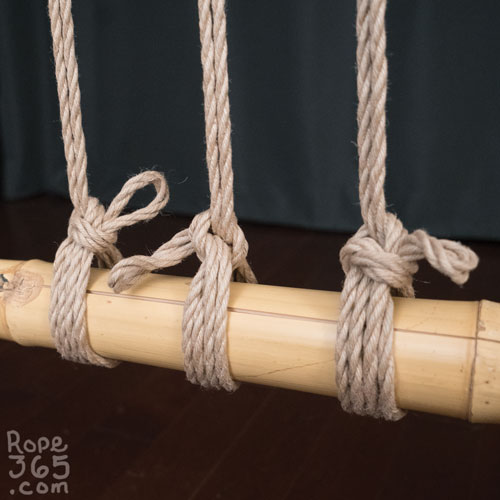 Day 193: Somerville Variations – The Somerville bowline from Day 1 has the benefit of never collapsing but can get difficult to untie under load. Different variations emerged to make improvements to this knot. Day 193: Somerville Variations – The Somerville bowline from Day 1 has the benefit of never collapsing but can get difficult to untie under load. Different variations emerged to make improvements to this knot.
Somerville bowline Handling Variations – We can find many different handling techniques to tie the Somerville bowline. If the topology of the knot remains the same, the finger movement will affect tension and speed. Compare different methods and find the one that works for you. East Somerville bowline – aka Strugglers knot – This knot is slightly easier to tie than the usual Somerville. It is easier to get even tension across the wraps but is slightly less compact and less stable. Burlington bowline – This single column tie begins with a half knot (first step of the square or granny knot) and ends with the Somerville bowline knot. This makes the tie a bit easier to handle but adds an extra step that makes it slower and bulkier. Inspirations and Resources
|
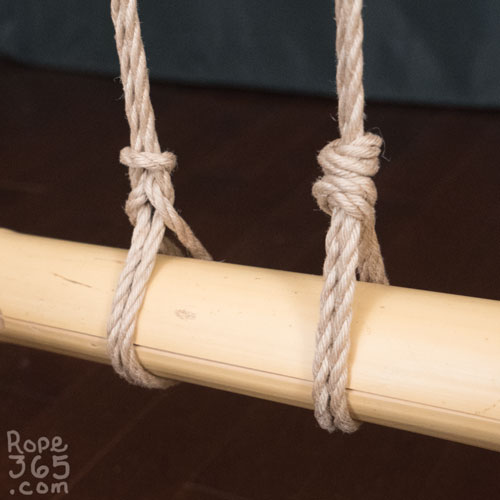 Day 194: Sliding Cuffs – Some cuff ties can be pre-tied to be inserted on the limb. Usually, a slip knot would tighten down and cinch but these cuffs rely on the rope friction to stay in place. This allows for speed both to slip in and slip out, but should be avoided if structural stability is required. Popular variations of this concept are the Cats Paw cuff and the Zip Snare. These ties are often used for wrists and ankles in sex bondage and work best with slippery ropes like nylon or MFP. Day 194: Sliding Cuffs – Some cuff ties can be pre-tied to be inserted on the limb. Usually, a slip knot would tighten down and cinch but these cuffs rely on the rope friction to stay in place. This allows for speed both to slip in and slip out, but should be avoided if structural stability is required. Popular variations of this concept are the Cats Paw cuff and the Zip Snare. These ties are often used for wrists and ankles in sex bondage and work best with slippery ropes like nylon or MFP.
Inspirations and Resources |
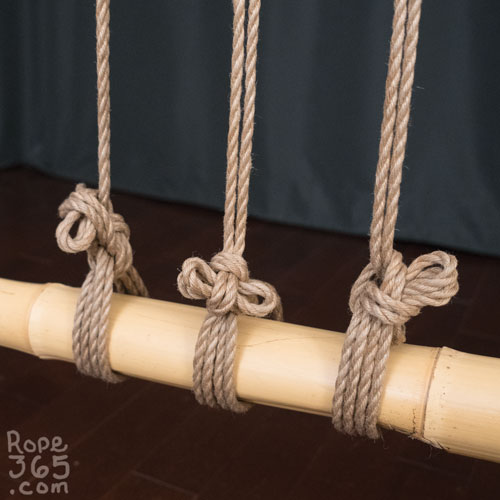 Day 195: Quick Release – Many single column tie knots can be modified to become a quick release tie, allowing to swiftly untie at any time. This can be achieved by pulling the bight halfway through and tightening the knot to keep it in place. We can also use the daisy chain principle from Day 186 to create something that unties easily. Quick releases can be a saviour in case of emergency but they also come with compromises, the knot will be less stable, impossible to lock, and the bight cannot be used as an attachment point. Try to make a quick release version of the reverse french bowline, the Somerville and try to create a daisy chain single column. Day 195: Quick Release – Many single column tie knots can be modified to become a quick release tie, allowing to swiftly untie at any time. This can be achieved by pulling the bight halfway through and tightening the knot to keep it in place. We can also use the daisy chain principle from Day 186 to create something that unties easily. Quick releases can be a saviour in case of emergency but they also come with compromises, the knot will be less stable, impossible to lock, and the bight cannot be used as an attachment point. Try to make a quick release version of the reverse french bowline, the Somerville and try to create a daisy chain single column.
|
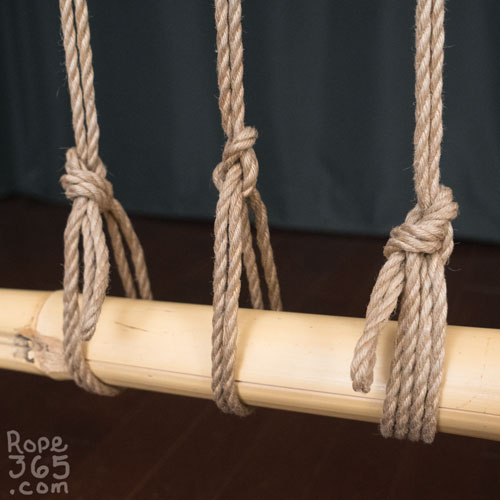 Day 196: More Bowlines – Bowlines are an entire family of knots with a lot of different approaches. It is interesting to tap into the vast knowledge of nautical knots and rescue knots to discover new techniques. Look up ties like the french bowline, the bowline on a bight and the Portuguese bowline. What’s your favourite bowline? Day 196: More Bowlines – Bowlines are an entire family of knots with a lot of different approaches. It is interesting to tap into the vast knowledge of nautical knots and rescue knots to discover new techniques. Look up ties like the french bowline, the bowline on a bight and the Portuguese bowline. What’s your favourite bowline?
Inspirations and Resources |
Overview

Video References
We compiled a Youtube playlist with various videos on this topic, let us know if you find others we should add to this list. Note that video references may display risky or unstable techniques, viewer discernment is advised.
Gallery
Inspirations and Resources
- Note On Knot Selection by WykD Dave
- Bola Bola or Somerville – hints on when to use which by Mrluckiesrope
- The Single Column Guide by Rory’s Brainworks
- Forward & Reverse Tension Column Ties by Innovative Fiber Arts
- Cat’s Cradle Cuff by Monkey Fetish
- Leon’s Knot (Captured Half Hitch?) by MonkeyFetish
- Self-Tightening Column Ties by Kinetik Speicher
- Why use what knot by Wykd Dave
- Kaa’s cuff by Innovative Fiber Arts
- Introduction to Single and Double Column Ties by Kinetik Speicher
- Performance column tie by Ben Hart
- Surgeon single column by Dunter
Credit: R/P: Ebi McKnotty








Leave a Reply